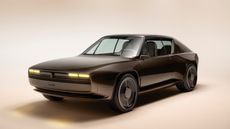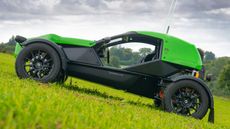With the Lucid Air and now the Lucid Gravity, the Californian EV maker is redefining luxury
As the Lucid Gravity debuts, Derek Jenkins, Lucid Motors’ SVP of Brand and Design, discusses the EV company's approach to shaping high-end, high-performance electric cars

This is the new Lucid Gravity, an electric SUV designed and built by the Californian manufacturer Lucid as the second car in its line-up after the Lucid Air. Currently on sale in the US and Canada, as well as Switzerland, Germany, Norway, The Netherlands, Saudi Arabia and the UAE, the Air has ensured Lucid achieved escape velocity from start-up status. Its focus is 100 per cent on high-end products that start where other EV specialists end their ranges.

Lucid Gravity
Up until now, the only Lucid on sale has been the Air, a large luxury saloon offering a twist on the classic combustion-era proportions. Instead of a long bonnet and boot (or hood and trunk, perhaps), the Air’s silhouette priortises the passenger cabin, with a long wheelbase and short overhangs. As well as using a ‘skateboard’ of batteries (the LEAP, or Lucid Electric Advanced Platform) underpinning the car to increase physical scale and space, Lucid is also using technology as a way of creating a new form of luxury.

Lucid Gravity interior sketch
We spoke to Derek Jenkins, Lucid’s SVP of Brand and Design, about the brand’s approach and how this is one of the only ways a brand-new company can tackle the persistent hegemony of heritage and history that has defined luxury automotive design up until now. Jenkins has been at Lucid since 2015, back when the company was still known as Atieva.

Design sketches of the Gravity's 'frunk'-mounted seating
Atieva was founded way back in 2007, in the very early days of electrification, and through a series of acquisitions, mergers and partnerships, it eventually emerged as Lucid Motors in late 2016. At this point, company pivoted from supplying batteries and powertrains to making its own car. This is when the Air was first shown in concept form.

Lucid Gravity exterior sketch
Jenkins was formerly director of design at Mazda North America Operations, and before that he was chief designer for Volkswagen North America, the studio that created the Scirocco concept, Ragster, Microbus concept, and Concept T. He’s also worked for Audi, where he was the principal exterior designer of the cult aluminium-bodied A2 concept and production cars and the elegant 2002 Audi A8. Parlaying this experience into luxury EVs has proved an engaging challenge.

Lucid Gravity exterior sketch
Jenkins sets out the four keystones of Lucid’s approach to luxury. For a start, there’s the compact drivetrain that allows for huge internal spaces, not just in the passenger cabin but in the luggage compartments. ‘Range is our next key point,’ he says, ‘it’s code for efficiency. The Air achieves 5 miles per KwH – it’s the most aerodynamic luxury saloon on the market.’ Next up is performance. No surprises here, for EVs have had a power advantage over their ICE forebears since forever.

Lucid Air Sapphire
That said, the flagship Air, the Sapphire, has the equivalent of 1,234 horsepower, hits 60mph in under two seconds and tops out at well over 200mph. The most efficient Air, the Grand Touring model, has a 512-mile range. EV aficionados know full well that you can’t explore extremes of range and performance at the same time, or even in the same model, but it shows Lucid’s breadth of ability and confidence in its components and engineering.
Wallpaper* Newsletter
Receive our daily digest of inspiration, escapism and design stories from around the world direct to your inbox.

Lucid Air Sapphire dashboard
Finally, there is luxury. For us, ‘this means mindfulness, sustainability, materials and the user experience’, says Jenkins, ‘the starting point for all of this was our Californian DNA. When it comes to vehicles, the place of origin really matters. All great auto brands wear this on their sleeve.’
The Air’s proportions came out of studying ‘decades and decades of internal combustion cars’. ‘Long hoods symbolised more cylinders and therefore more power,’ Jenkins explains, ‘a grille is essentially an abstracted radiator. We found we could move the passengers forward and make the cabin longer… it’s a non-traditional approach that is better for space and access.’ Another influence was aviation’s ‘golden age’, ‘from the 1940s to the 1960s, when aircraft were these pure, honest machines’, Jenkins says. Even the Air’s large trunk opening evokes a cargo plane.
Lucid Gravity, an electric SUV coming in 2025

Lucid Gravity
If the Air is the ultimate Cali cruiser, the Gravity is presumably the SUV to conquer the state’s many and varied terrains and lifestyles. ‘California is a unique place,’ the designer continues, ‘it has amazing natural geography, lifestyle, icons of art, culture and technology. We felt it was a really good bedrock to build a brand on.’ He points out that California has long been at the cutting edge of American car culture, ‘from racing and custom cars, to the transition to importing small cars after the oil crisis. Hybrid and electrification [also] have their roots in California.’

Lucid Gravity, Tahoe edition interior
Crucially, luxury values are shifting, and Jenkins believes that Lucid is well placed to tap into a new generation of high-end consumer. ‘There’s a new way to express personal success, if you like,’ he says. ‘You see it across architecture, interiors, health and wellness, etc.’ Lucid’s models are designed in California and built in Arizona, with the factory now expanded to include the start of Gravity production in 2025.

Lucid Motors Tahoe edition cabin
Given the US is so SUV-centric, why start with a sedan? ‘We debated this extensively in 2015,’ Jenkins admits. ‘We always knew we’d be an advanced technology company and therefore a luxury brand. We felt that efficiency, long-range, handling and performance were all best demonstrated by a sedan.’ Nevertheless, it’s a shrinking segment as buyers turn to SUVs and crossovers.

Lucid Gravity Tahoe edition interior details
According to Jenkins, ‘the lessons learned with Air have made Gravity a better SUV’. Despite the infusion of Cali-culture, Jenkins admits that both vehicles ‘were conceived with a strong dose of European influence. We’re not solely looking at things from an American point of view.’ Unlike other recent electric SUVs and trucks, Air and Gravity easily fit into European road infrastructure, although they’re still big cars.

Lucid Gravity Tahoe edition, second row seating
Other aspects of Lucid’s new luxury approach include the way the company approaches its spacious interiors. In the Air, the rear seats are trimmed a different shade to the front. ‘It creates a space that feels more lounge-like and open,’ says Jenkins. In the Gravity, rear seats have folding laptop tables, because ‘people would rather have their own gear, not monster screens in front of them [all the time].’ The Gravity can carry up to seven people, or the load area can haul up to three mountain bikes, making it both sensible and sybaritic. ‘This is a primary household vehicle,’ says Jenkins, ‘you need the flexible space.’

The Lucid Gravity is a luxurious all-rounder
Interiors and materials draw inspiration from contemporary furniture design and leather goods companies, with open-pore woods, unfussy surfaces and a feeling of warmth and tactility. Unlike some competitors, Lucid isn’t going all-out with customisation options. ‘We’ve looked at bespoke programmes,’ Jenkins says, ‘but we’ve taken the approach of creating a simple set of curated themes named after California locations – Yosemite, Tahoe, Mojave and Ojai.

Lucid Gravity interior details
So where do Lucid’s customers come from, now and in the future. ‘Most obviously, it’s our Californian neighbour,’ Jenkins says diplomatically. ‘People are ready for something new. But we also have former owners of Audi, BMW, Mercedes, Lexus. Consumer values are changing and people are very conscious of what a luxury vehicle says about them. Lucid has an aura of new luxury.’ Happily for Jenkins and his team, this evolution has run alongside Lucid’s growth as a company.

Lucid Gravity
Was this intentional? ‘To a degree, it was a leap of faith. We had some market research, but we’ve definitely evolved it along the way. You have to make it happen,’ he says, adding that Lucid will continue to innovate and evolve. ‘If you look at the car industry, any time there’s a big tech innovation there follows a period of rapid change, and that affects people’s taste. With all the increased competition, we’re going to have to run pretty hard and fast to keep things fresh.’

Lucid Gravity
Lucid Air, from $69,900 for the Air Pure model to $249,000 for the Lucid Air Sapphire, LucidMotors.com, @LucidMotors
Lucid Gravity, coming soon, details at LucidMotors.com
Jonathan Bell has written for Wallpaper* magazine since 1999, covering everything from architecture and transport design to books, tech and graphic design. He is now the magazine’s Transport and Technology Editor. Jonathan has written and edited 15 books, including Concept Car Design, 21st Century House, and The New Modern House. He is also the host of Wallpaper’s first podcast.
-
 Three new coffee makers for a contemporary brew, from a casual cup to a full-on branded espresso
Three new coffee makers for a contemporary brew, from a casual cup to a full-on branded espressoThree new coffee makers, from AeroPress, Jura and Porsche x La Marzocco, range from the defiantly manual to the bells and whistles of a traditional countertop espresso machine
By Jonathan Bell Published
-
 Don't miss Luxembourg's retro-futuristic lab pavilion in Venice
Don't miss Luxembourg's retro-futuristic lab pavilion in VeniceAs the Venice Biennale enters its last few weeks, catch 'A Comparative Dialogue Act' at the Luxembourg Pavilion
By Amah-Rose Abrams Published
-
 A Berlin park atop an office building offers a new model of urban landscaping
A Berlin park atop an office building offers a new model of urban landscapingA Berlin park and office space by Grüntuch Ernst Architeken offer a symbiotic relationship between urban design and green living materials
By Michael Webb Published
-
 All hail the arrival of true autonomy? On Tesla’s proposed Robotaxi and techno-insecurity
All hail the arrival of true autonomy? On Tesla’s proposed Robotaxi and techno-insecurityTesla’s new marketing push predicts a future of robot cabs, automated buses and autonomous home androids. We already want to get off
By Jonathan Bell Published
-
 We report from the theatrical, laser-lit launch of Lynk & Co’s first European EV, the 02
We report from the theatrical, laser-lit launch of Lynk & Co’s first European EV, the 02In the future, will we treat cars like streaming services and simply subscribe to them? That’s one way that Lynk & Co envisages customers getting into their cars, including the new 02 EV
By Jonathan Bell Published
-
 We make off with a MOKE and experience the cult EV on the sunny backroads of Surrey
We make off with a MOKE and experience the cult EV on the sunny backroads of SurreyMOKE is a cult car with a bright future. Wallpaper* sat down with the company's new CEO Nick English to discuss his future plans for this very British beach machine
By Jonathan Bell Published
-
 The mibot is a tiny single-seater ‘mobility robot’ for traversing Japan’s crowded city centres
The mibot is a tiny single-seater ‘mobility robot’ for traversing Japan’s crowded city centresJapan is the undisputed centre of compact car culture, and KG Motors' new mibot is one of a new wave of micro-EVs that look set to take the country’s cities by storm
By Jonathan Bell Published
-
 Ora-ïto transforms the Renault 17 into a futuristic yet retro-tinged vision
Ora-ïto transforms the Renault 17 into a futuristic yet retro-tinged visionThe R17 electric restomod x Ora-ïto is the fourth in Renault's series of designer-led reimaginings of iconic models from its past. We think it's the best of the lot
By Jonathan Bell Published
-
 Specialist car-maker Ariel explorers the power of electrification with the E-Nomad concept
Specialist car-maker Ariel explorers the power of electrification with the E-Nomad conceptThe Ariel E-Nomad is an all-electric, go-anywhere sports car concept for the dedicated enthusiast. Could it be the shape of sporting EVs to come?
By Jonathan Bell Published
-
 A new exhibition at Los Angeles’ Petersen Auto Museum charts the rocky road to electric cars
A new exhibition at Los Angeles’ Petersen Auto Museum charts the rocky road to electric cars‘Alternating Currents: The Fall and Rise of Electric Vehicles’ brings together EVs old and new, from forgotten prototypes to legendary innovations. We take a tour
By Jonathan Bell Published
-
 Four tiny electric motors offer a space-saving take on modern urban transport
Four tiny electric motors offer a space-saving take on modern urban transportThis quartet of ultra-compact city cars prove that big is definitely not better when it comes to last mile, last minute short haul travel in a built up area
By Jonathan Bell Published